Strategies and Practices for Hotel Restaurants to Remain Competitive
VerifiedAdded on 2023/06/04
|14
|3811
|207
AI Summary
This report focuses on the food and beverage services in the hotel industry, identifying the challenges faced by hotels and resorts in the changing industry. It provides a classification of restaurants and bars, their differences, advantages, and disadvantages. The report investigates the strategies and practices adopted by hotel restaurants to remain competitive against standalone establishments, including drive-thru food eateries, fine dine restaurants, fast casual restaurants, cafes and bistros, and bars. The report also discusses the trends in the industry, particularly the impact of social media on customer behavior and the role of marketing and social media activities in creating a competitive advantage.
Contribute Materials
Your contribution can guide someone’s learning journey. Share your
documents today.
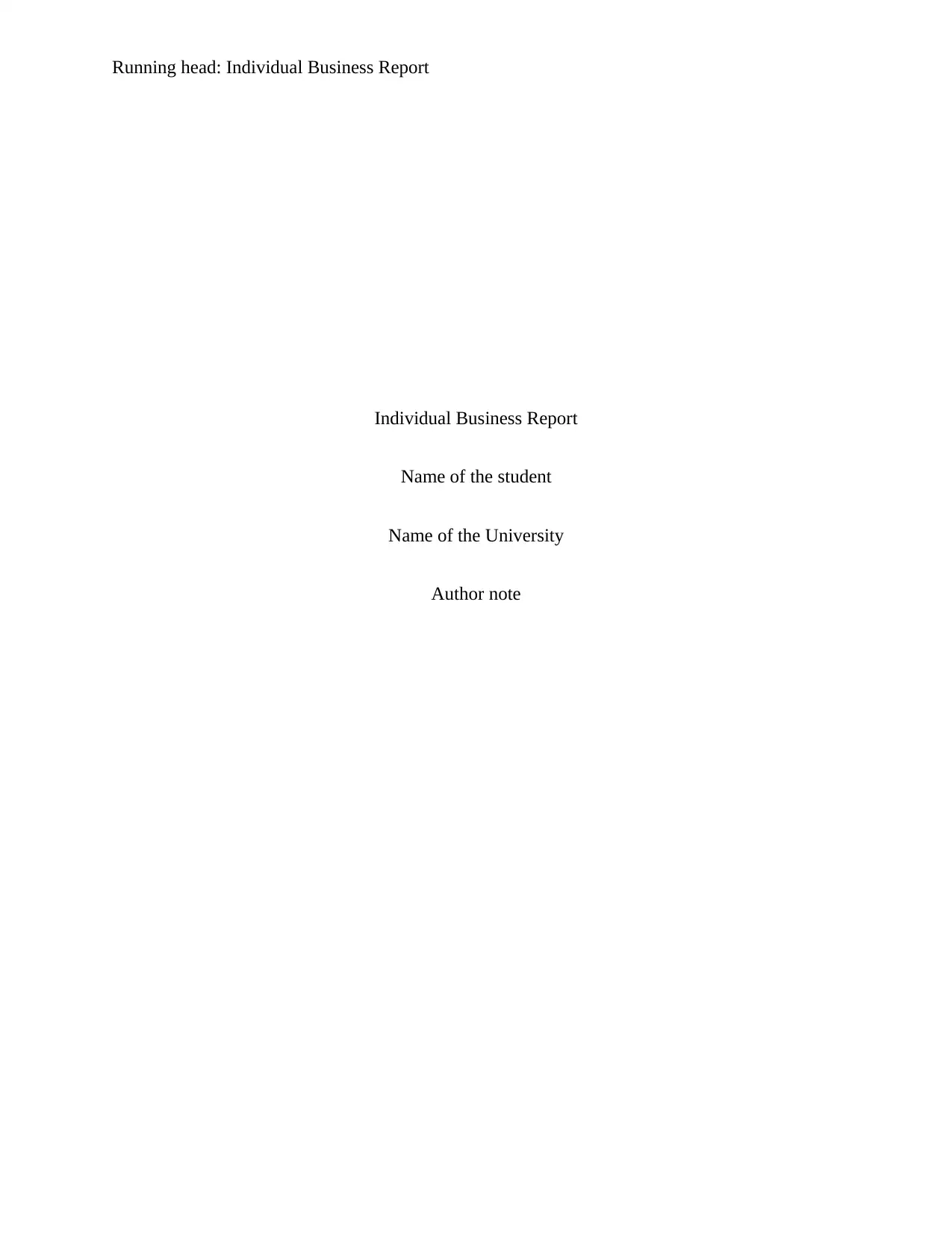
Running head: Individual Business Report
Individual Business Report
Name of the student
Name of the University
Author note
Individual Business Report
Name of the student
Name of the University
Author note
Secure Best Marks with AI Grader
Need help grading? Try our AI Grader for instant feedback on your assignments.
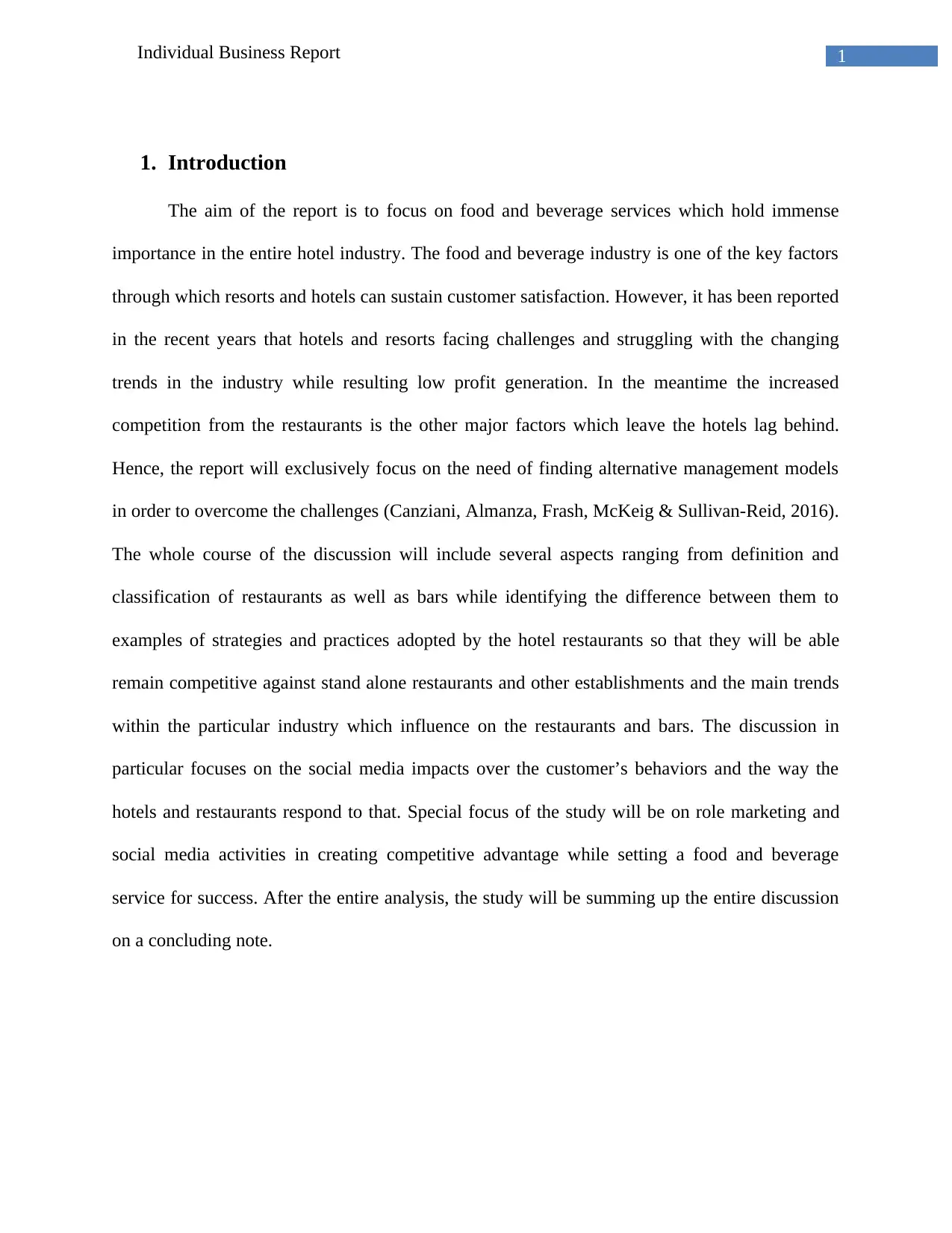
1Individual Business Report
1. Introduction
The aim of the report is to focus on food and beverage services which hold immense
importance in the entire hotel industry. The food and beverage industry is one of the key factors
through which resorts and hotels can sustain customer satisfaction. However, it has been reported
in the recent years that hotels and resorts facing challenges and struggling with the changing
trends in the industry while resulting low profit generation. In the meantime the increased
competition from the restaurants is the other major factors which leave the hotels lag behind.
Hence, the report will exclusively focus on the need of finding alternative management models
in order to overcome the challenges (Canziani, Almanza, Frash, McKeig & Sullivan-Reid, 2016).
The whole course of the discussion will include several aspects ranging from definition and
classification of restaurants as well as bars while identifying the difference between them to
examples of strategies and practices adopted by the hotel restaurants so that they will be able
remain competitive against stand alone restaurants and other establishments and the main trends
within the particular industry which influence on the restaurants and bars. The discussion in
particular focuses on the social media impacts over the customer’s behaviors and the way the
hotels and restaurants respond to that. Special focus of the study will be on role marketing and
social media activities in creating competitive advantage while setting a food and beverage
service for success. After the entire analysis, the study will be summing up the entire discussion
on a concluding note.
1. Introduction
The aim of the report is to focus on food and beverage services which hold immense
importance in the entire hotel industry. The food and beverage industry is one of the key factors
through which resorts and hotels can sustain customer satisfaction. However, it has been reported
in the recent years that hotels and resorts facing challenges and struggling with the changing
trends in the industry while resulting low profit generation. In the meantime the increased
competition from the restaurants is the other major factors which leave the hotels lag behind.
Hence, the report will exclusively focus on the need of finding alternative management models
in order to overcome the challenges (Canziani, Almanza, Frash, McKeig & Sullivan-Reid, 2016).
The whole course of the discussion will include several aspects ranging from definition and
classification of restaurants as well as bars while identifying the difference between them to
examples of strategies and practices adopted by the hotel restaurants so that they will be able
remain competitive against stand alone restaurants and other establishments and the main trends
within the particular industry which influence on the restaurants and bars. The discussion in
particular focuses on the social media impacts over the customer’s behaviors and the way the
hotels and restaurants respond to that. Special focus of the study will be on role marketing and
social media activities in creating competitive advantage while setting a food and beverage
service for success. After the entire analysis, the study will be summing up the entire discussion
on a concluding note.
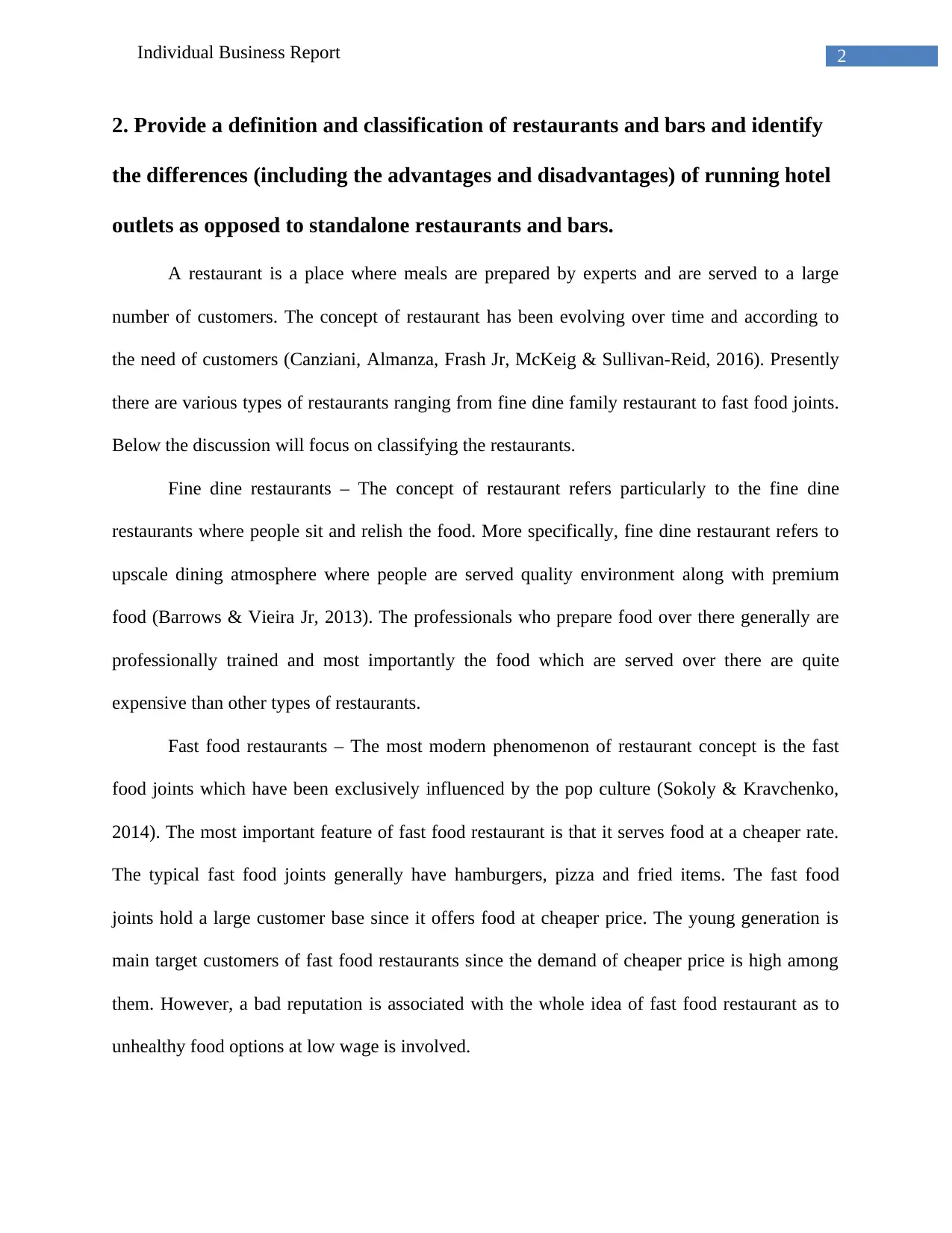
2Individual Business Report
2. Provide a definition and classification of restaurants and bars and identify
the differences (including the advantages and disadvantages) of running hotel
outlets as opposed to standalone restaurants and bars.
A restaurant is a place where meals are prepared by experts and are served to a large
number of customers. The concept of restaurant has been evolving over time and according to
the need of customers (Canziani, Almanza, Frash Jr, McKeig & Sullivan-Reid, 2016). Presently
there are various types of restaurants ranging from fine dine family restaurant to fast food joints.
Below the discussion will focus on classifying the restaurants.
Fine dine restaurants – The concept of restaurant refers particularly to the fine dine
restaurants where people sit and relish the food. More specifically, fine dine restaurant refers to
upscale dining atmosphere where people are served quality environment along with premium
food (Barrows & Vieira Jr, 2013). The professionals who prepare food over there generally are
professionally trained and most importantly the food which are served over there are quite
expensive than other types of restaurants.
Fast food restaurants – The most modern phenomenon of restaurant concept is the fast
food joints which have been exclusively influenced by the pop culture (Sokoly & Kravchenko,
2014). The most important feature of fast food restaurant is that it serves food at a cheaper rate.
The typical fast food joints generally have hamburgers, pizza and fried items. The fast food
joints hold a large customer base since it offers food at cheaper price. The young generation is
main target customers of fast food restaurants since the demand of cheaper price is high among
them. However, a bad reputation is associated with the whole idea of fast food restaurant as to
unhealthy food options at low wage is involved.
2. Provide a definition and classification of restaurants and bars and identify
the differences (including the advantages and disadvantages) of running hotel
outlets as opposed to standalone restaurants and bars.
A restaurant is a place where meals are prepared by experts and are served to a large
number of customers. The concept of restaurant has been evolving over time and according to
the need of customers (Canziani, Almanza, Frash Jr, McKeig & Sullivan-Reid, 2016). Presently
there are various types of restaurants ranging from fine dine family restaurant to fast food joints.
Below the discussion will focus on classifying the restaurants.
Fine dine restaurants – The concept of restaurant refers particularly to the fine dine
restaurants where people sit and relish the food. More specifically, fine dine restaurant refers to
upscale dining atmosphere where people are served quality environment along with premium
food (Barrows & Vieira Jr, 2013). The professionals who prepare food over there generally are
professionally trained and most importantly the food which are served over there are quite
expensive than other types of restaurants.
Fast food restaurants – The most modern phenomenon of restaurant concept is the fast
food joints which have been exclusively influenced by the pop culture (Sokoly & Kravchenko,
2014). The most important feature of fast food restaurant is that it serves food at a cheaper rate.
The typical fast food joints generally have hamburgers, pizza and fried items. The fast food
joints hold a large customer base since it offers food at cheaper price. The young generation is
main target customers of fast food restaurants since the demand of cheaper price is high among
them. However, a bad reputation is associated with the whole idea of fast food restaurant as to
unhealthy food options at low wage is involved.
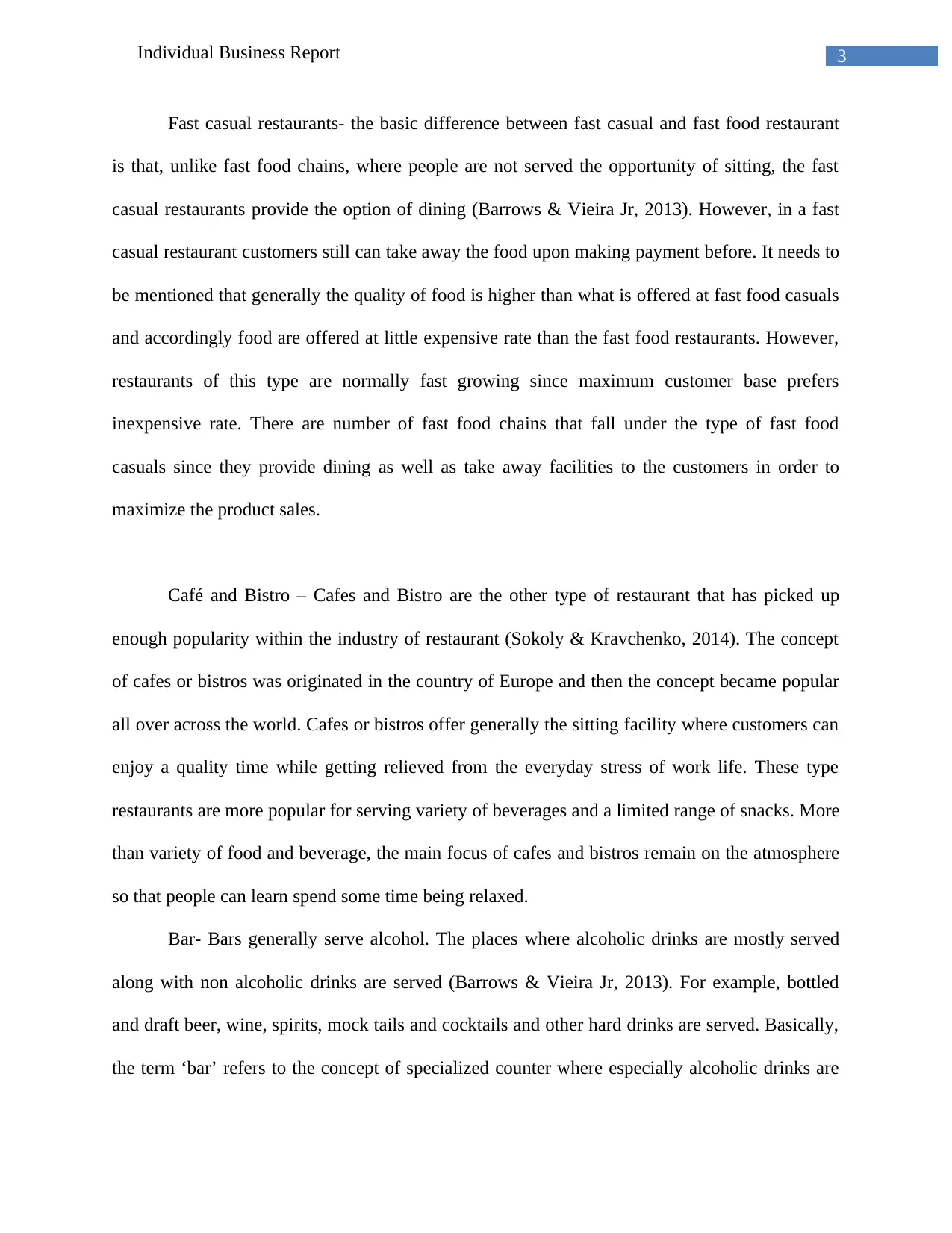
3Individual Business Report
Fast casual restaurants- the basic difference between fast casual and fast food restaurant
is that, unlike fast food chains, where people are not served the opportunity of sitting, the fast
casual restaurants provide the option of dining (Barrows & Vieira Jr, 2013). However, in a fast
casual restaurant customers still can take away the food upon making payment before. It needs to
be mentioned that generally the quality of food is higher than what is offered at fast food casuals
and accordingly food are offered at little expensive rate than the fast food restaurants. However,
restaurants of this type are normally fast growing since maximum customer base prefers
inexpensive rate. There are number of fast food chains that fall under the type of fast food
casuals since they provide dining as well as take away facilities to the customers in order to
maximize the product sales.
Café and Bistro – Cafes and Bistro are the other type of restaurant that has picked up
enough popularity within the industry of restaurant (Sokoly & Kravchenko, 2014). The concept
of cafes or bistros was originated in the country of Europe and then the concept became popular
all over across the world. Cafes or bistros offer generally the sitting facility where customers can
enjoy a quality time while getting relieved from the everyday stress of work life. These type
restaurants are more popular for serving variety of beverages and a limited range of snacks. More
than variety of food and beverage, the main focus of cafes and bistros remain on the atmosphere
so that people can learn spend some time being relaxed.
Bar- Bars generally serve alcohol. The places where alcoholic drinks are mostly served
along with non alcoholic drinks are served (Barrows & Vieira Jr, 2013). For example, bottled
and draft beer, wine, spirits, mock tails and cocktails and other hard drinks are served. Basically,
the term ‘bar’ refers to the concept of specialized counter where especially alcoholic drinks are
Fast casual restaurants- the basic difference between fast casual and fast food restaurant
is that, unlike fast food chains, where people are not served the opportunity of sitting, the fast
casual restaurants provide the option of dining (Barrows & Vieira Jr, 2013). However, in a fast
casual restaurant customers still can take away the food upon making payment before. It needs to
be mentioned that generally the quality of food is higher than what is offered at fast food casuals
and accordingly food are offered at little expensive rate than the fast food restaurants. However,
restaurants of this type are normally fast growing since maximum customer base prefers
inexpensive rate. There are number of fast food chains that fall under the type of fast food
casuals since they provide dining as well as take away facilities to the customers in order to
maximize the product sales.
Café and Bistro – Cafes and Bistro are the other type of restaurant that has picked up
enough popularity within the industry of restaurant (Sokoly & Kravchenko, 2014). The concept
of cafes or bistros was originated in the country of Europe and then the concept became popular
all over across the world. Cafes or bistros offer generally the sitting facility where customers can
enjoy a quality time while getting relieved from the everyday stress of work life. These type
restaurants are more popular for serving variety of beverages and a limited range of snacks. More
than variety of food and beverage, the main focus of cafes and bistros remain on the atmosphere
so that people can learn spend some time being relaxed.
Bar- Bars generally serve alcohol. The places where alcoholic drinks are mostly served
along with non alcoholic drinks are served (Barrows & Vieira Jr, 2013). For example, bottled
and draft beer, wine, spirits, mock tails and cocktails and other hard drinks are served. Basically,
the term ‘bar’ refers to the concept of specialized counter where especially alcoholic drinks are
Secure Best Marks with AI Grader
Need help grading? Try our AI Grader for instant feedback on your assignments.
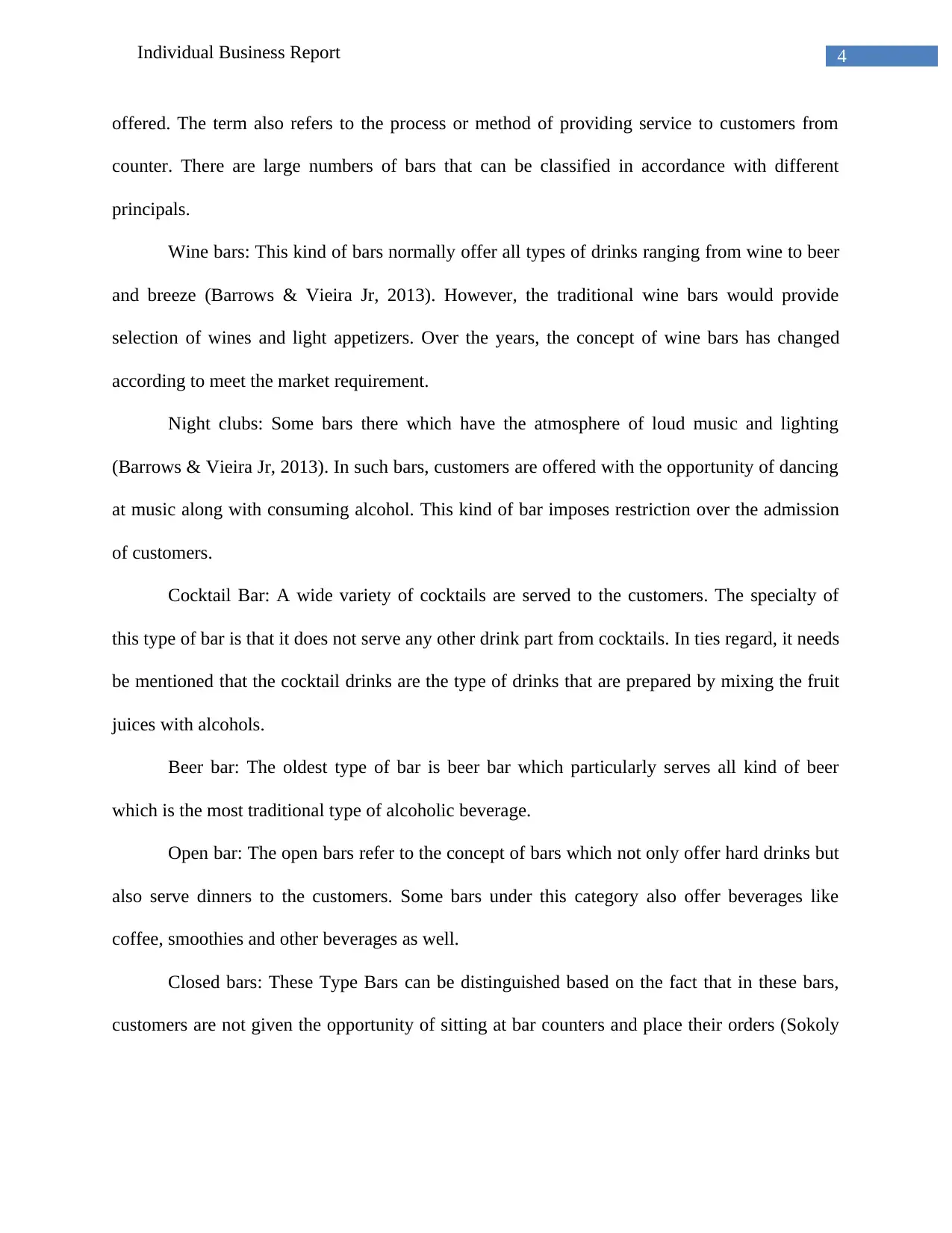
4Individual Business Report
offered. The term also refers to the process or method of providing service to customers from
counter. There are large numbers of bars that can be classified in accordance with different
principals.
Wine bars: This kind of bars normally offer all types of drinks ranging from wine to beer
and breeze (Barrows & Vieira Jr, 2013). However, the traditional wine bars would provide
selection of wines and light appetizers. Over the years, the concept of wine bars has changed
according to meet the market requirement.
Night clubs: Some bars there which have the atmosphere of loud music and lighting
(Barrows & Vieira Jr, 2013). In such bars, customers are offered with the opportunity of dancing
at music along with consuming alcohol. This kind of bar imposes restriction over the admission
of customers.
Cocktail Bar: A wide variety of cocktails are served to the customers. The specialty of
this type of bar is that it does not serve any other drink part from cocktails. In ties regard, it needs
be mentioned that the cocktail drinks are the type of drinks that are prepared by mixing the fruit
juices with alcohols.
Beer bar: The oldest type of bar is beer bar which particularly serves all kind of beer
which is the most traditional type of alcoholic beverage.
Open bar: The open bars refer to the concept of bars which not only offer hard drinks but
also serve dinners to the customers. Some bars under this category also offer beverages like
coffee, smoothies and other beverages as well.
Closed bars: These Type Bars can be distinguished based on the fact that in these bars,
customers are not given the opportunity of sitting at bar counters and place their orders (Sokoly
offered. The term also refers to the process or method of providing service to customers from
counter. There are large numbers of bars that can be classified in accordance with different
principals.
Wine bars: This kind of bars normally offer all types of drinks ranging from wine to beer
and breeze (Barrows & Vieira Jr, 2013). However, the traditional wine bars would provide
selection of wines and light appetizers. Over the years, the concept of wine bars has changed
according to meet the market requirement.
Night clubs: Some bars there which have the atmosphere of loud music and lighting
(Barrows & Vieira Jr, 2013). In such bars, customers are offered with the opportunity of dancing
at music along with consuming alcohol. This kind of bar imposes restriction over the admission
of customers.
Cocktail Bar: A wide variety of cocktails are served to the customers. The specialty of
this type of bar is that it does not serve any other drink part from cocktails. In ties regard, it needs
be mentioned that the cocktail drinks are the type of drinks that are prepared by mixing the fruit
juices with alcohols.
Beer bar: The oldest type of bar is beer bar which particularly serves all kind of beer
which is the most traditional type of alcoholic beverage.
Open bar: The open bars refer to the concept of bars which not only offer hard drinks but
also serve dinners to the customers. Some bars under this category also offer beverages like
coffee, smoothies and other beverages as well.
Closed bars: These Type Bars can be distinguished based on the fact that in these bars,
customers are not given the opportunity of sitting at bar counters and place their orders (Sokoly
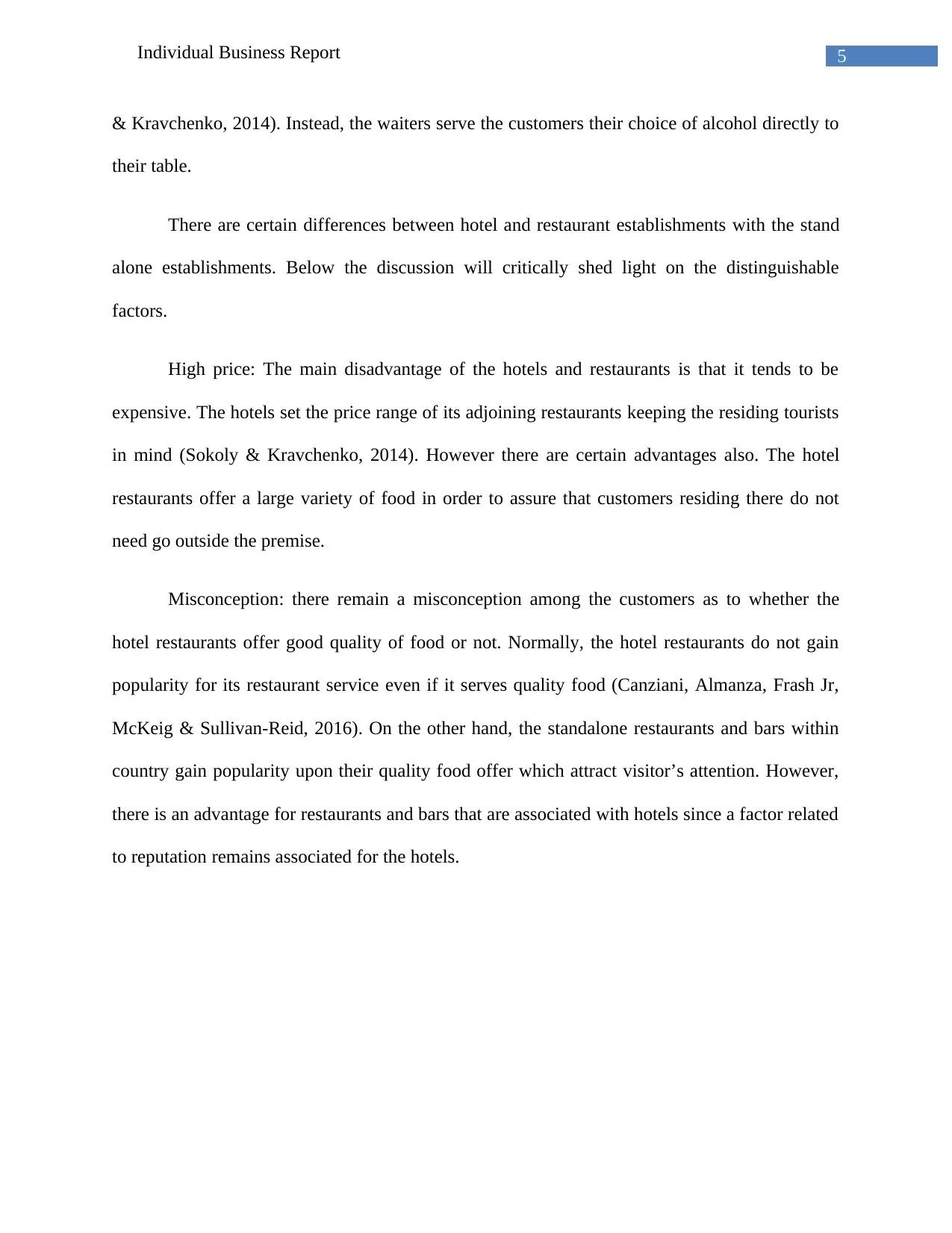
5Individual Business Report
& Kravchenko, 2014). Instead, the waiters serve the customers their choice of alcohol directly to
their table.
There are certain differences between hotel and restaurant establishments with the stand
alone establishments. Below the discussion will critically shed light on the distinguishable
factors.
High price: The main disadvantage of the hotels and restaurants is that it tends to be
expensive. The hotels set the price range of its adjoining restaurants keeping the residing tourists
in mind (Sokoly & Kravchenko, 2014). However there are certain advantages also. The hotel
restaurants offer a large variety of food in order to assure that customers residing there do not
need go outside the premise.
Misconception: there remain a misconception among the customers as to whether the
hotel restaurants offer good quality of food or not. Normally, the hotel restaurants do not gain
popularity for its restaurant service even if it serves quality food (Canziani, Almanza, Frash Jr,
McKeig & Sullivan-Reid, 2016). On the other hand, the standalone restaurants and bars within
country gain popularity upon their quality food offer which attract visitor’s attention. However,
there is an advantage for restaurants and bars that are associated with hotels since a factor related
to reputation remains associated for the hotels.
& Kravchenko, 2014). Instead, the waiters serve the customers their choice of alcohol directly to
their table.
There are certain differences between hotel and restaurant establishments with the stand
alone establishments. Below the discussion will critically shed light on the distinguishable
factors.
High price: The main disadvantage of the hotels and restaurants is that it tends to be
expensive. The hotels set the price range of its adjoining restaurants keeping the residing tourists
in mind (Sokoly & Kravchenko, 2014). However there are certain advantages also. The hotel
restaurants offer a large variety of food in order to assure that customers residing there do not
need go outside the premise.
Misconception: there remain a misconception among the customers as to whether the
hotel restaurants offer good quality of food or not. Normally, the hotel restaurants do not gain
popularity for its restaurant service even if it serves quality food (Canziani, Almanza, Frash Jr,
McKeig & Sullivan-Reid, 2016). On the other hand, the standalone restaurants and bars within
country gain popularity upon their quality food offer which attract visitor’s attention. However,
there is an advantage for restaurants and bars that are associated with hotels since a factor related
to reputation remains associated for the hotels.
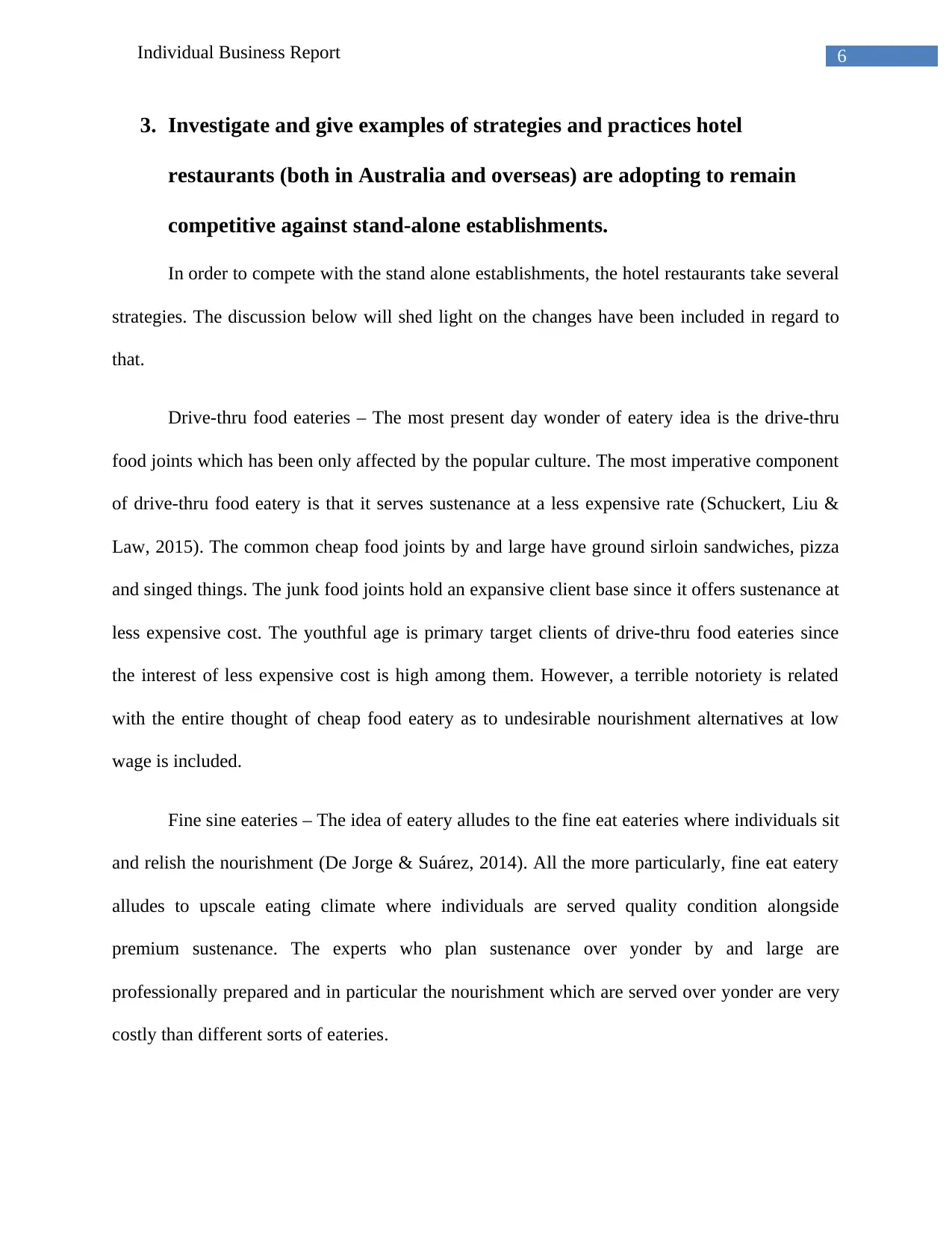
6Individual Business Report
3. Investigate and give examples of strategies and practices hotel
restaurants (both in Australia and overseas) are adopting to remain
competitive against stand-alone establishments.
In order to compete with the stand alone establishments, the hotel restaurants take several
strategies. The discussion below will shed light on the changes have been included in regard to
that.
Drive-thru food eateries – The most present day wonder of eatery idea is the drive-thru
food joints which has been only affected by the popular culture. The most imperative component
of drive-thru food eatery is that it serves sustenance at a less expensive rate (Schuckert, Liu &
Law, 2015). The common cheap food joints by and large have ground sirloin sandwiches, pizza
and singed things. The junk food joints hold an expansive client base since it offers sustenance at
less expensive cost. The youthful age is primary target clients of drive-thru food eateries since
the interest of less expensive cost is high among them. However, a terrible notoriety is related
with the entire thought of cheap food eatery as to undesirable nourishment alternatives at low
wage is included.
Fine sine eateries – The idea of eatery alludes to the fine eat eateries where individuals sit
and relish the nourishment (De Jorge & Suárez, 2014). All the more particularly, fine eat eatery
alludes to upscale eating climate where individuals are served quality condition alongside
premium sustenance. The experts who plan sustenance over yonder by and large are
professionally prepared and in particular the nourishment which are served over yonder are very
costly than different sorts of eateries.
3. Investigate and give examples of strategies and practices hotel
restaurants (both in Australia and overseas) are adopting to remain
competitive against stand-alone establishments.
In order to compete with the stand alone establishments, the hotel restaurants take several
strategies. The discussion below will shed light on the changes have been included in regard to
that.
Drive-thru food eateries – The most present day wonder of eatery idea is the drive-thru
food joints which has been only affected by the popular culture. The most imperative component
of drive-thru food eatery is that it serves sustenance at a less expensive rate (Schuckert, Liu &
Law, 2015). The common cheap food joints by and large have ground sirloin sandwiches, pizza
and singed things. The junk food joints hold an expansive client base since it offers sustenance at
less expensive cost. The youthful age is primary target clients of drive-thru food eateries since
the interest of less expensive cost is high among them. However, a terrible notoriety is related
with the entire thought of cheap food eatery as to undesirable nourishment alternatives at low
wage is included.
Fine sine eateries – The idea of eatery alludes to the fine eat eateries where individuals sit
and relish the nourishment (De Jorge & Suárez, 2014). All the more particularly, fine eat eatery
alludes to upscale eating climate where individuals are served quality condition alongside
premium sustenance. The experts who plan sustenance over yonder by and large are
professionally prepared and in particular the nourishment which are served over yonder are very
costly than different sorts of eateries.
Paraphrase This Document
Need a fresh take? Get an instant paraphrase of this document with our AI Paraphraser
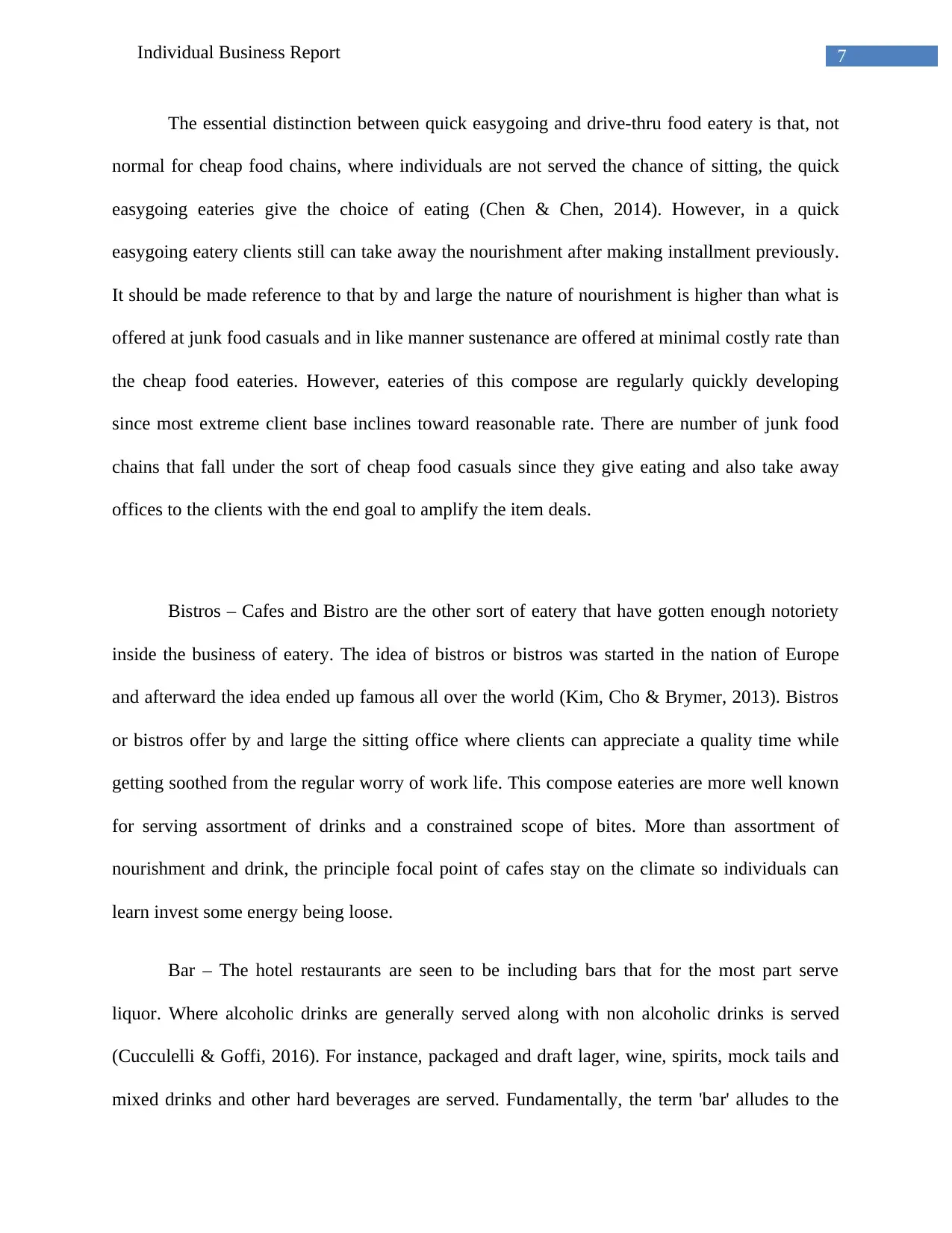
7Individual Business Report
The essential distinction between quick easygoing and drive-thru food eatery is that, not
normal for cheap food chains, where individuals are not served the chance of sitting, the quick
easygoing eateries give the choice of eating (Chen & Chen, 2014). However, in a quick
easygoing eatery clients still can take away the nourishment after making installment previously.
It should be made reference to that by and large the nature of nourishment is higher than what is
offered at junk food casuals and in like manner sustenance are offered at minimal costly rate than
the cheap food eateries. However, eateries of this compose are regularly quickly developing
since most extreme client base inclines toward reasonable rate. There are number of junk food
chains that fall under the sort of cheap food casuals since they give eating and also take away
offices to the clients with the end goal to amplify the item deals.
Bistros – Cafes and Bistro are the other sort of eatery that have gotten enough notoriety
inside the business of eatery. The idea of bistros or bistros was started in the nation of Europe
and afterward the idea ended up famous all over the world (Kim, Cho & Brymer, 2013). Bistros
or bistros offer by and large the sitting office where clients can appreciate a quality time while
getting soothed from the regular worry of work life. This compose eateries are more well known
for serving assortment of drinks and a constrained scope of bites. More than assortment of
nourishment and drink, the principle focal point of cafes stay on the climate so individuals can
learn invest some energy being loose.
Bar – The hotel restaurants are seen to be including bars that for the most part serve
liquor. Where alcoholic drinks are generally served along with non alcoholic drinks is served
(Cucculelli & Goffi, 2016). For instance, packaged and draft lager, wine, spirits, mock tails and
mixed drinks and other hard beverages are served. Fundamentally, the term 'bar' alludes to the
The essential distinction between quick easygoing and drive-thru food eatery is that, not
normal for cheap food chains, where individuals are not served the chance of sitting, the quick
easygoing eateries give the choice of eating (Chen & Chen, 2014). However, in a quick
easygoing eatery clients still can take away the nourishment after making installment previously.
It should be made reference to that by and large the nature of nourishment is higher than what is
offered at junk food casuals and in like manner sustenance are offered at minimal costly rate than
the cheap food eateries. However, eateries of this compose are regularly quickly developing
since most extreme client base inclines toward reasonable rate. There are number of junk food
chains that fall under the sort of cheap food casuals since they give eating and also take away
offices to the clients with the end goal to amplify the item deals.
Bistros – Cafes and Bistro are the other sort of eatery that have gotten enough notoriety
inside the business of eatery. The idea of bistros or bistros was started in the nation of Europe
and afterward the idea ended up famous all over the world (Kim, Cho & Brymer, 2013). Bistros
or bistros offer by and large the sitting office where clients can appreciate a quality time while
getting soothed from the regular worry of work life. This compose eateries are more well known
for serving assortment of drinks and a constrained scope of bites. More than assortment of
nourishment and drink, the principle focal point of cafes stay on the climate so individuals can
learn invest some energy being loose.
Bar – The hotel restaurants are seen to be including bars that for the most part serve
liquor. Where alcoholic drinks are generally served along with non alcoholic drinks is served
(Cucculelli & Goffi, 2016). For instance, packaged and draft lager, wine, spirits, mock tails and
mixed drinks and other hard beverages are served. Fundamentally, the term 'bar' alludes to the
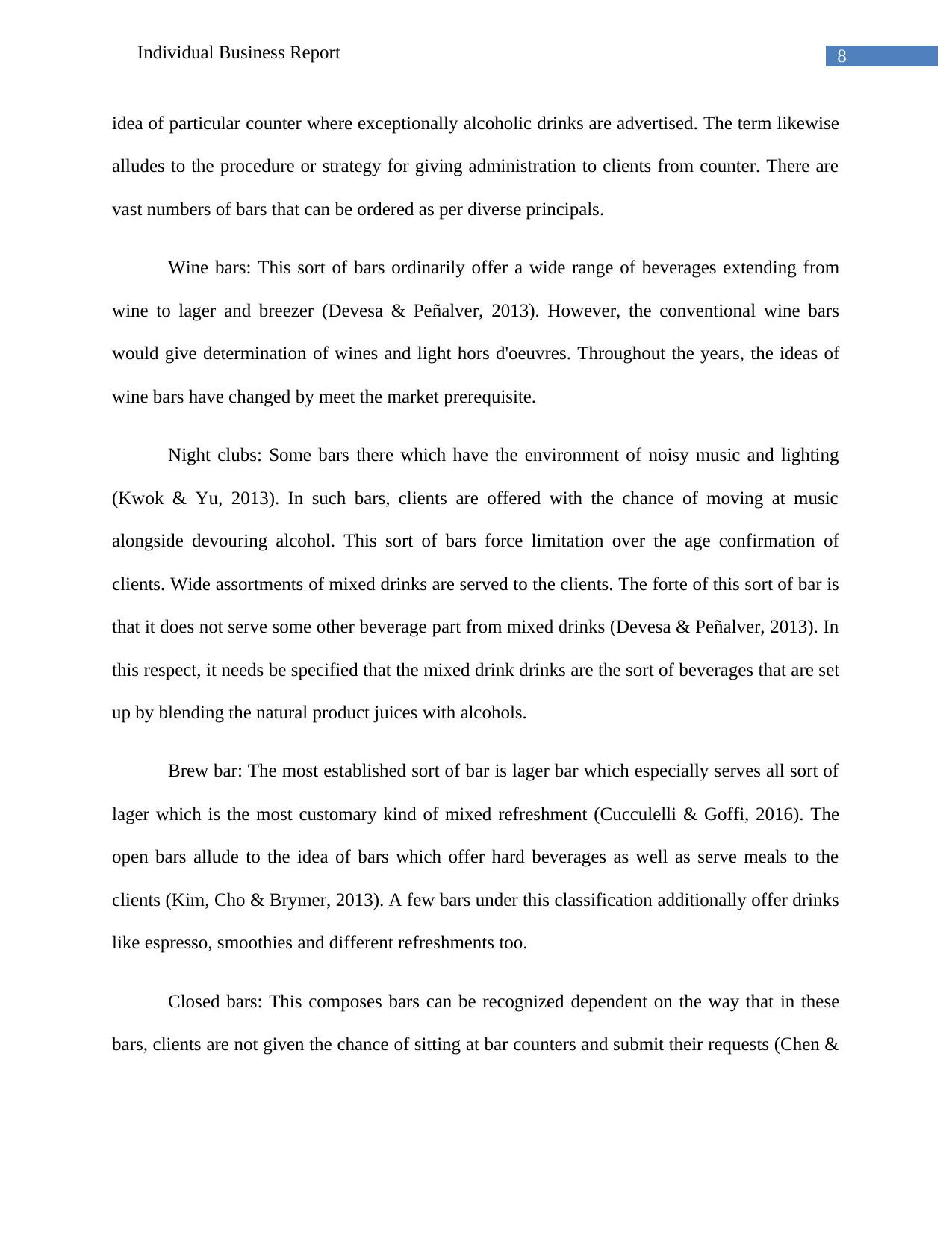
8Individual Business Report
idea of particular counter where exceptionally alcoholic drinks are advertised. The term likewise
alludes to the procedure or strategy for giving administration to clients from counter. There are
vast numbers of bars that can be ordered as per diverse principals.
Wine bars: This sort of bars ordinarily offer a wide range of beverages extending from
wine to lager and breezer (Devesa & Peñalver, 2013). However, the conventional wine bars
would give determination of wines and light hors d'oeuvres. Throughout the years, the ideas of
wine bars have changed by meet the market prerequisite.
Night clubs: Some bars there which have the environment of noisy music and lighting
(Kwok & Yu, 2013). In such bars, clients are offered with the chance of moving at music
alongside devouring alcohol. This sort of bars force limitation over the age confirmation of
clients. Wide assortments of mixed drinks are served to the clients. The forte of this sort of bar is
that it does not serve some other beverage part from mixed drinks (Devesa & Peñalver, 2013). In
this respect, it needs be specified that the mixed drink drinks are the sort of beverages that are set
up by blending the natural product juices with alcohols.
Brew bar: The most established sort of bar is lager bar which especially serves all sort of
lager which is the most customary kind of mixed refreshment (Cucculelli & Goffi, 2016). The
open bars allude to the idea of bars which offer hard beverages as well as serve meals to the
clients (Kim, Cho & Brymer, 2013). A few bars under this classification additionally offer drinks
like espresso, smoothies and different refreshments too.
Closed bars: This composes bars can be recognized dependent on the way that in these
bars, clients are not given the chance of sitting at bar counters and submit their requests (Chen &
idea of particular counter where exceptionally alcoholic drinks are advertised. The term likewise
alludes to the procedure or strategy for giving administration to clients from counter. There are
vast numbers of bars that can be ordered as per diverse principals.
Wine bars: This sort of bars ordinarily offer a wide range of beverages extending from
wine to lager and breezer (Devesa & Peñalver, 2013). However, the conventional wine bars
would give determination of wines and light hors d'oeuvres. Throughout the years, the ideas of
wine bars have changed by meet the market prerequisite.
Night clubs: Some bars there which have the environment of noisy music and lighting
(Kwok & Yu, 2013). In such bars, clients are offered with the chance of moving at music
alongside devouring alcohol. This sort of bars force limitation over the age confirmation of
clients. Wide assortments of mixed drinks are served to the clients. The forte of this sort of bar is
that it does not serve some other beverage part from mixed drinks (Devesa & Peñalver, 2013). In
this respect, it needs be specified that the mixed drink drinks are the sort of beverages that are set
up by blending the natural product juices with alcohols.
Brew bar: The most established sort of bar is lager bar which especially serves all sort of
lager which is the most customary kind of mixed refreshment (Cucculelli & Goffi, 2016). The
open bars allude to the idea of bars which offer hard beverages as well as serve meals to the
clients (Kim, Cho & Brymer, 2013). A few bars under this classification additionally offer drinks
like espresso, smoothies and different refreshments too.
Closed bars: This composes bars can be recognized dependent on the way that in these
bars, clients are not given the chance of sitting at bar counters and submit their requests (Chen &
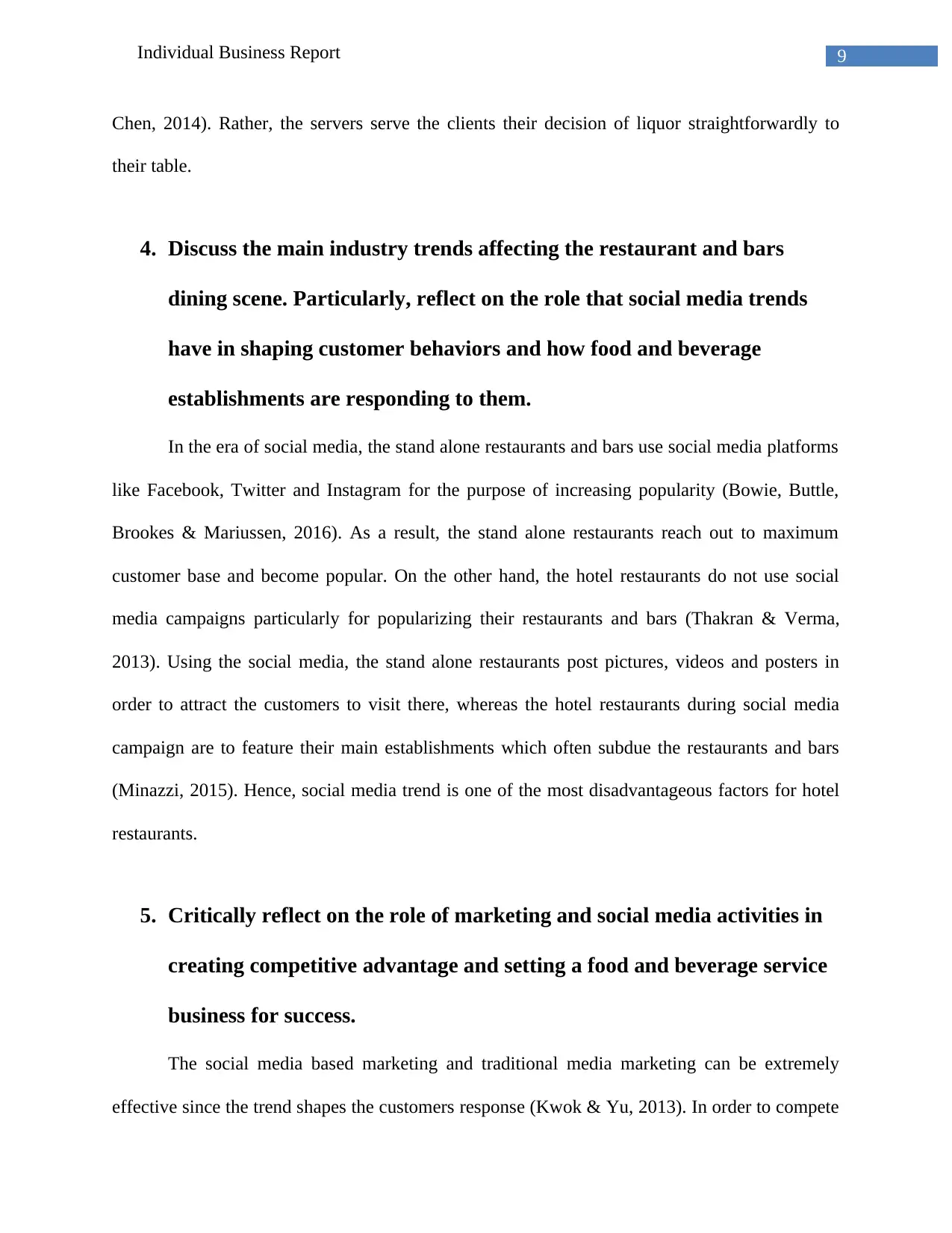
9Individual Business Report
Chen, 2014). Rather, the servers serve the clients their decision of liquor straightforwardly to
their table.
4. Discuss the main industry trends affecting the restaurant and bars
dining scene. Particularly, reflect on the role that social media trends
have in shaping customer behaviors and how food and beverage
establishments are responding to them.
In the era of social media, the stand alone restaurants and bars use social media platforms
like Facebook, Twitter and Instagram for the purpose of increasing popularity (Bowie, Buttle,
Brookes & Mariussen, 2016). As a result, the stand alone restaurants reach out to maximum
customer base and become popular. On the other hand, the hotel restaurants do not use social
media campaigns particularly for popularizing their restaurants and bars (Thakran & Verma,
2013). Using the social media, the stand alone restaurants post pictures, videos and posters in
order to attract the customers to visit there, whereas the hotel restaurants during social media
campaign are to feature their main establishments which often subdue the restaurants and bars
(Minazzi, 2015). Hence, social media trend is one of the most disadvantageous factors for hotel
restaurants.
5. Critically reflect on the role of marketing and social media activities in
creating competitive advantage and setting a food and beverage service
business for success.
The social media based marketing and traditional media marketing can be extremely
effective since the trend shapes the customers response (Kwok & Yu, 2013). In order to compete
Chen, 2014). Rather, the servers serve the clients their decision of liquor straightforwardly to
their table.
4. Discuss the main industry trends affecting the restaurant and bars
dining scene. Particularly, reflect on the role that social media trends
have in shaping customer behaviors and how food and beverage
establishments are responding to them.
In the era of social media, the stand alone restaurants and bars use social media platforms
like Facebook, Twitter and Instagram for the purpose of increasing popularity (Bowie, Buttle,
Brookes & Mariussen, 2016). As a result, the stand alone restaurants reach out to maximum
customer base and become popular. On the other hand, the hotel restaurants do not use social
media campaigns particularly for popularizing their restaurants and bars (Thakran & Verma,
2013). Using the social media, the stand alone restaurants post pictures, videos and posters in
order to attract the customers to visit there, whereas the hotel restaurants during social media
campaign are to feature their main establishments which often subdue the restaurants and bars
(Minazzi, 2015). Hence, social media trend is one of the most disadvantageous factors for hotel
restaurants.
5. Critically reflect on the role of marketing and social media activities in
creating competitive advantage and setting a food and beverage service
business for success.
The social media based marketing and traditional media marketing can be extremely
effective since the trend shapes the customers response (Kwok & Yu, 2013). In order to compete
Secure Best Marks with AI Grader
Need help grading? Try our AI Grader for instant feedback on your assignments.
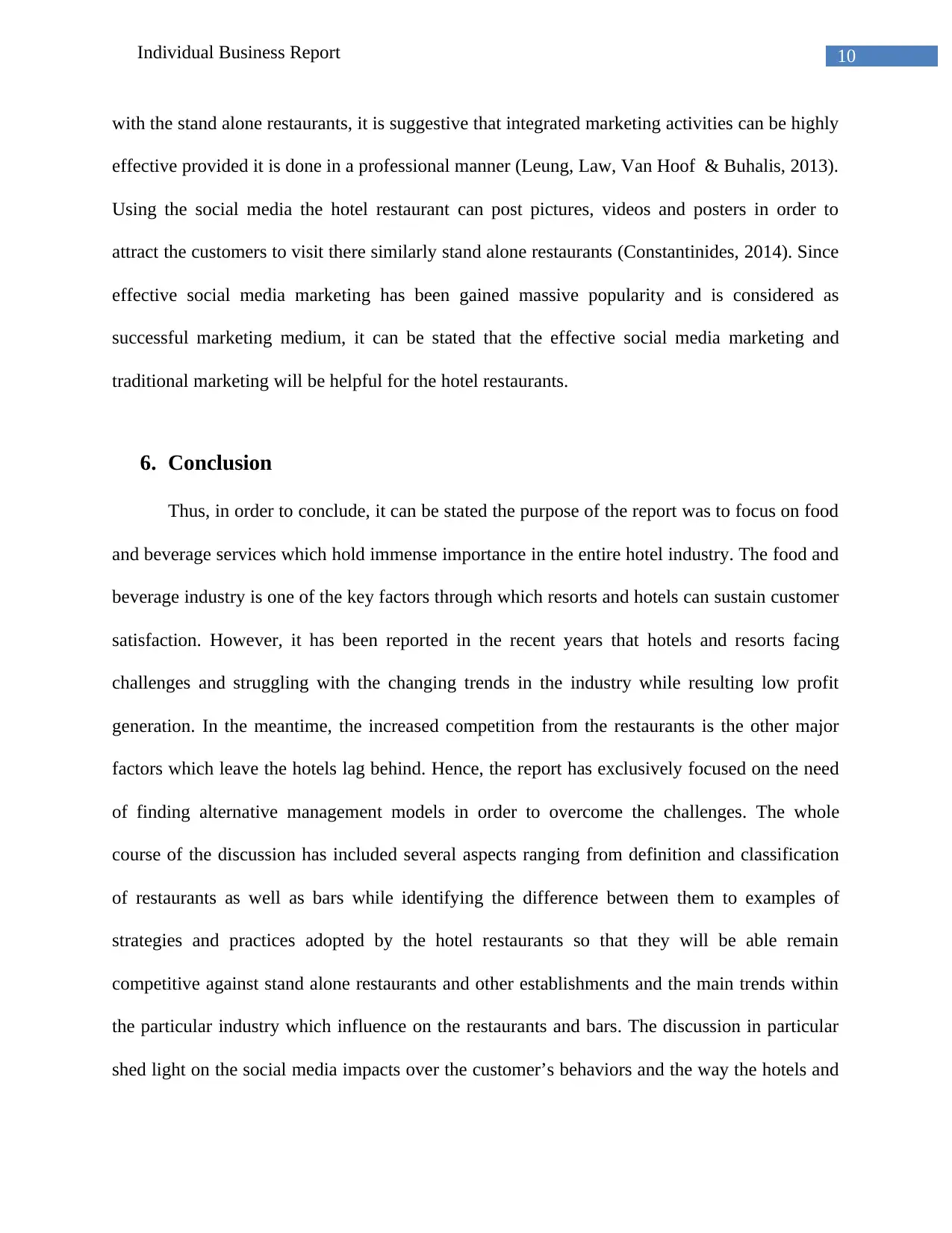
10Individual Business Report
with the stand alone restaurants, it is suggestive that integrated marketing activities can be highly
effective provided it is done in a professional manner (Leung, Law, Van Hoof & Buhalis, 2013).
Using the social media the hotel restaurant can post pictures, videos and posters in order to
attract the customers to visit there similarly stand alone restaurants (Constantinides, 2014). Since
effective social media marketing has been gained massive popularity and is considered as
successful marketing medium, it can be stated that the effective social media marketing and
traditional marketing will be helpful for the hotel restaurants.
6. Conclusion
Thus, in order to conclude, it can be stated the purpose of the report was to focus on food
and beverage services which hold immense importance in the entire hotel industry. The food and
beverage industry is one of the key factors through which resorts and hotels can sustain customer
satisfaction. However, it has been reported in the recent years that hotels and resorts facing
challenges and struggling with the changing trends in the industry while resulting low profit
generation. In the meantime, the increased competition from the restaurants is the other major
factors which leave the hotels lag behind. Hence, the report has exclusively focused on the need
of finding alternative management models in order to overcome the challenges. The whole
course of the discussion has included several aspects ranging from definition and classification
of restaurants as well as bars while identifying the difference between them to examples of
strategies and practices adopted by the hotel restaurants so that they will be able remain
competitive against stand alone restaurants and other establishments and the main trends within
the particular industry which influence on the restaurants and bars. The discussion in particular
shed light on the social media impacts over the customer’s behaviors and the way the hotels and
with the stand alone restaurants, it is suggestive that integrated marketing activities can be highly
effective provided it is done in a professional manner (Leung, Law, Van Hoof & Buhalis, 2013).
Using the social media the hotel restaurant can post pictures, videos and posters in order to
attract the customers to visit there similarly stand alone restaurants (Constantinides, 2014). Since
effective social media marketing has been gained massive popularity and is considered as
successful marketing medium, it can be stated that the effective social media marketing and
traditional marketing will be helpful for the hotel restaurants.
6. Conclusion
Thus, in order to conclude, it can be stated the purpose of the report was to focus on food
and beverage services which hold immense importance in the entire hotel industry. The food and
beverage industry is one of the key factors through which resorts and hotels can sustain customer
satisfaction. However, it has been reported in the recent years that hotels and resorts facing
challenges and struggling with the changing trends in the industry while resulting low profit
generation. In the meantime, the increased competition from the restaurants is the other major
factors which leave the hotels lag behind. Hence, the report has exclusively focused on the need
of finding alternative management models in order to overcome the challenges. The whole
course of the discussion has included several aspects ranging from definition and classification
of restaurants as well as bars while identifying the difference between them to examples of
strategies and practices adopted by the hotel restaurants so that they will be able remain
competitive against stand alone restaurants and other establishments and the main trends within
the particular industry which influence on the restaurants and bars. The discussion in particular
shed light on the social media impacts over the customer’s behaviors and the way the hotels and

11Individual Business Report
restaurants respond to that. Special focus of the study was on role marketing and social media
activities in creating competitive advantage while setting a food and beverage service for
success.
restaurants respond to that. Special focus of the study was on role marketing and social media
activities in creating competitive advantage while setting a food and beverage service for
success.
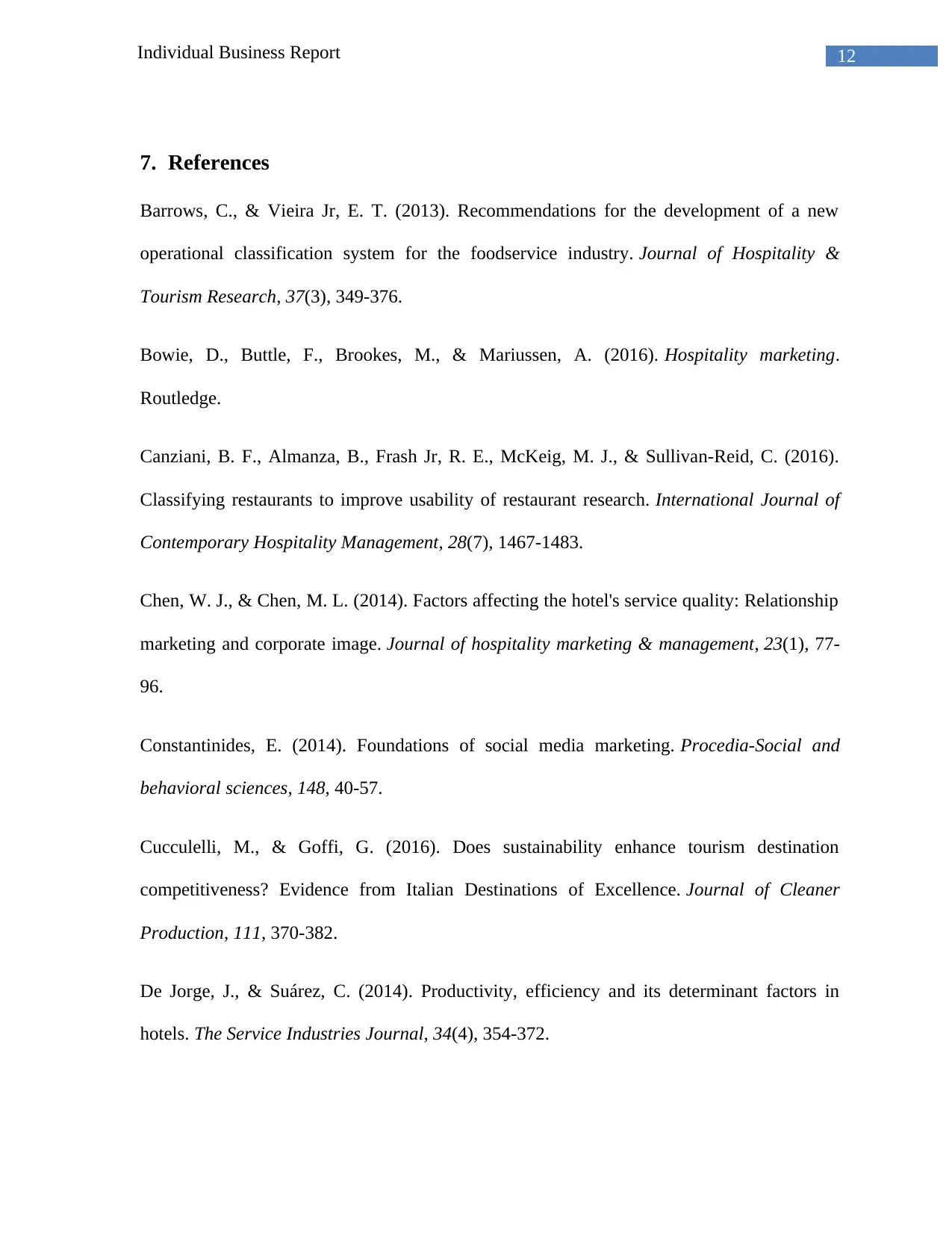
12Individual Business Report
7. References
Barrows, C., & Vieira Jr, E. T. (2013). Recommendations for the development of a new
operational classification system for the foodservice industry. Journal of Hospitality &
Tourism Research, 37(3), 349-376.
Bowie, D., Buttle, F., Brookes, M., & Mariussen, A. (2016). Hospitality marketing.
Routledge.
Canziani, B. F., Almanza, B., Frash Jr, R. E., McKeig, M. J., & Sullivan-Reid, C. (2016).
Classifying restaurants to improve usability of restaurant research. International Journal of
Contemporary Hospitality Management, 28(7), 1467-1483.
Chen, W. J., & Chen, M. L. (2014). Factors affecting the hotel's service quality: Relationship
marketing and corporate image. Journal of hospitality marketing & management, 23(1), 77-
96.
Constantinides, E. (2014). Foundations of social media marketing. Procedia-Social and
behavioral sciences, 148, 40-57.
Cucculelli, M., & Goffi, G. (2016). Does sustainability enhance tourism destination
competitiveness? Evidence from Italian Destinations of Excellence. Journal of Cleaner
Production, 111, 370-382.
De Jorge, J., & Suárez, C. (2014). Productivity, efficiency and its determinant factors in
hotels. The Service Industries Journal, 34(4), 354-372.
7. References
Barrows, C., & Vieira Jr, E. T. (2013). Recommendations for the development of a new
operational classification system for the foodservice industry. Journal of Hospitality &
Tourism Research, 37(3), 349-376.
Bowie, D., Buttle, F., Brookes, M., & Mariussen, A. (2016). Hospitality marketing.
Routledge.
Canziani, B. F., Almanza, B., Frash Jr, R. E., McKeig, M. J., & Sullivan-Reid, C. (2016).
Classifying restaurants to improve usability of restaurant research. International Journal of
Contemporary Hospitality Management, 28(7), 1467-1483.
Chen, W. J., & Chen, M. L. (2014). Factors affecting the hotel's service quality: Relationship
marketing and corporate image. Journal of hospitality marketing & management, 23(1), 77-
96.
Constantinides, E. (2014). Foundations of social media marketing. Procedia-Social and
behavioral sciences, 148, 40-57.
Cucculelli, M., & Goffi, G. (2016). Does sustainability enhance tourism destination
competitiveness? Evidence from Italian Destinations of Excellence. Journal of Cleaner
Production, 111, 370-382.
De Jorge, J., & Suárez, C. (2014). Productivity, efficiency and its determinant factors in
hotels. The Service Industries Journal, 34(4), 354-372.
Paraphrase This Document
Need a fresh take? Get an instant paraphrase of this document with our AI Paraphraser
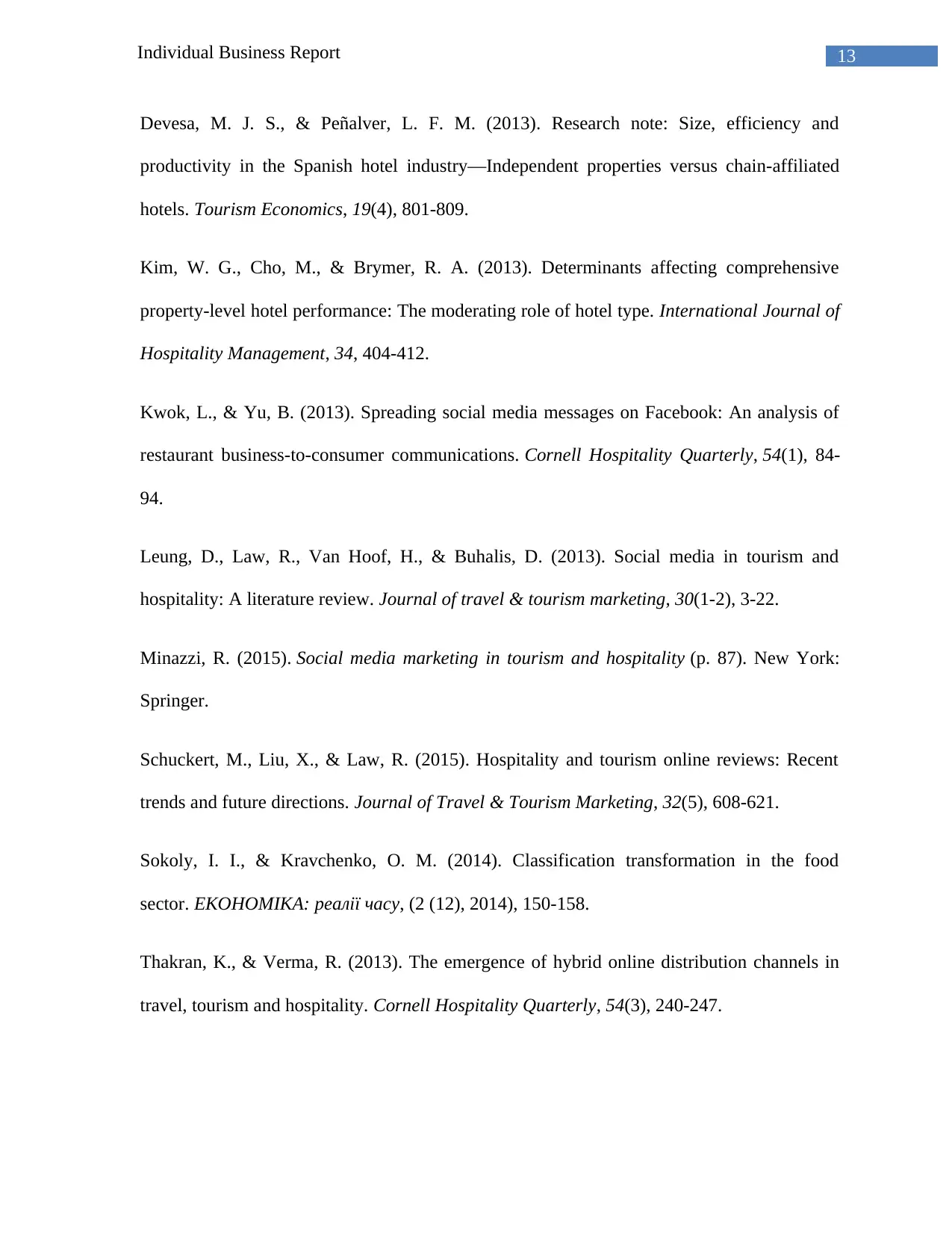
13Individual Business Report
Devesa, M. J. S., & Peñalver, L. F. M. (2013). Research note: Size, efficiency and
productivity in the Spanish hotel industry—Independent properties versus chain-affiliated
hotels. Tourism Economics, 19(4), 801-809.
Kim, W. G., Cho, M., & Brymer, R. A. (2013). Determinants affecting comprehensive
property-level hotel performance: The moderating role of hotel type. International Journal of
Hospitality Management, 34, 404-412.
Kwok, L., & Yu, B. (2013). Spreading social media messages on Facebook: An analysis of
restaurant business-to-consumer communications. Cornell Hospitality Quarterly, 54(1), 84-
94.
Leung, D., Law, R., Van Hoof, H., & Buhalis, D. (2013). Social media in tourism and
hospitality: A literature review. Journal of travel & tourism marketing, 30(1-2), 3-22.
Minazzi, R. (2015). Social media marketing in tourism and hospitality (p. 87). New York:
Springer.
Schuckert, M., Liu, X., & Law, R. (2015). Hospitality and tourism online reviews: Recent
trends and future directions. Journal of Travel & Tourism Marketing, 32(5), 608-621.
Sokoly, I. I., & Kravchenko, O. M. (2014). Classification transformation in the food
sector. ЕКОНОМІКА: реалії часу, (2 (12), 2014), 150-158.
Thakran, K., & Verma, R. (2013). The emergence of hybrid online distribution channels in
travel, tourism and hospitality. Cornell Hospitality Quarterly, 54(3), 240-247.
Devesa, M. J. S., & Peñalver, L. F. M. (2013). Research note: Size, efficiency and
productivity in the Spanish hotel industry—Independent properties versus chain-affiliated
hotels. Tourism Economics, 19(4), 801-809.
Kim, W. G., Cho, M., & Brymer, R. A. (2013). Determinants affecting comprehensive
property-level hotel performance: The moderating role of hotel type. International Journal of
Hospitality Management, 34, 404-412.
Kwok, L., & Yu, B. (2013). Spreading social media messages on Facebook: An analysis of
restaurant business-to-consumer communications. Cornell Hospitality Quarterly, 54(1), 84-
94.
Leung, D., Law, R., Van Hoof, H., & Buhalis, D. (2013). Social media in tourism and
hospitality: A literature review. Journal of travel & tourism marketing, 30(1-2), 3-22.
Minazzi, R. (2015). Social media marketing in tourism and hospitality (p. 87). New York:
Springer.
Schuckert, M., Liu, X., & Law, R. (2015). Hospitality and tourism online reviews: Recent
trends and future directions. Journal of Travel & Tourism Marketing, 32(5), 608-621.
Sokoly, I. I., & Kravchenko, O. M. (2014). Classification transformation in the food
sector. ЕКОНОМІКА: реалії часу, (2 (12), 2014), 150-158.
Thakran, K., & Verma, R. (2013). The emergence of hybrid online distribution channels in
travel, tourism and hospitality. Cornell Hospitality Quarterly, 54(3), 240-247.
1 out of 14
Related Documents
Your All-in-One AI-Powered Toolkit for Academic Success.
+13062052269
info@desklib.com
Available 24*7 on WhatsApp / Email
![[object Object]](/_next/static/media/star-bottom.7253800d.svg)
Unlock your academic potential
© 2024 | Zucol Services PVT LTD | All rights reserved.




